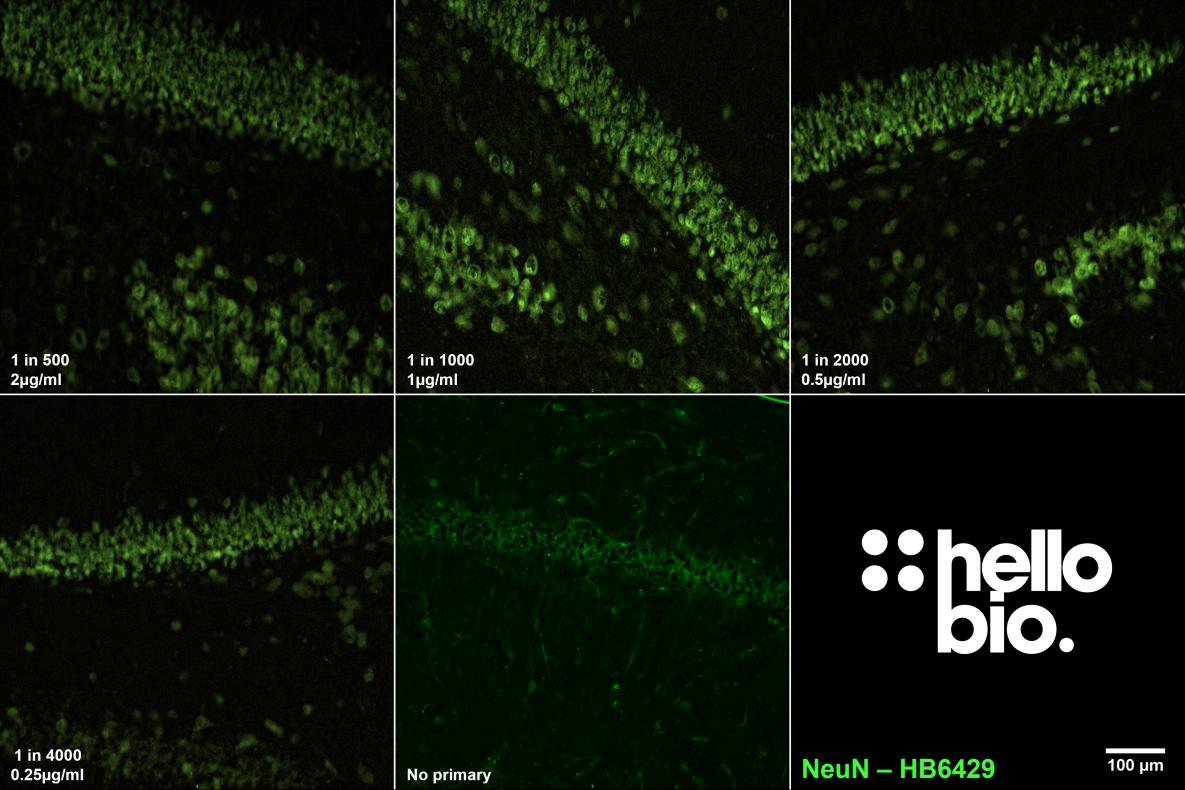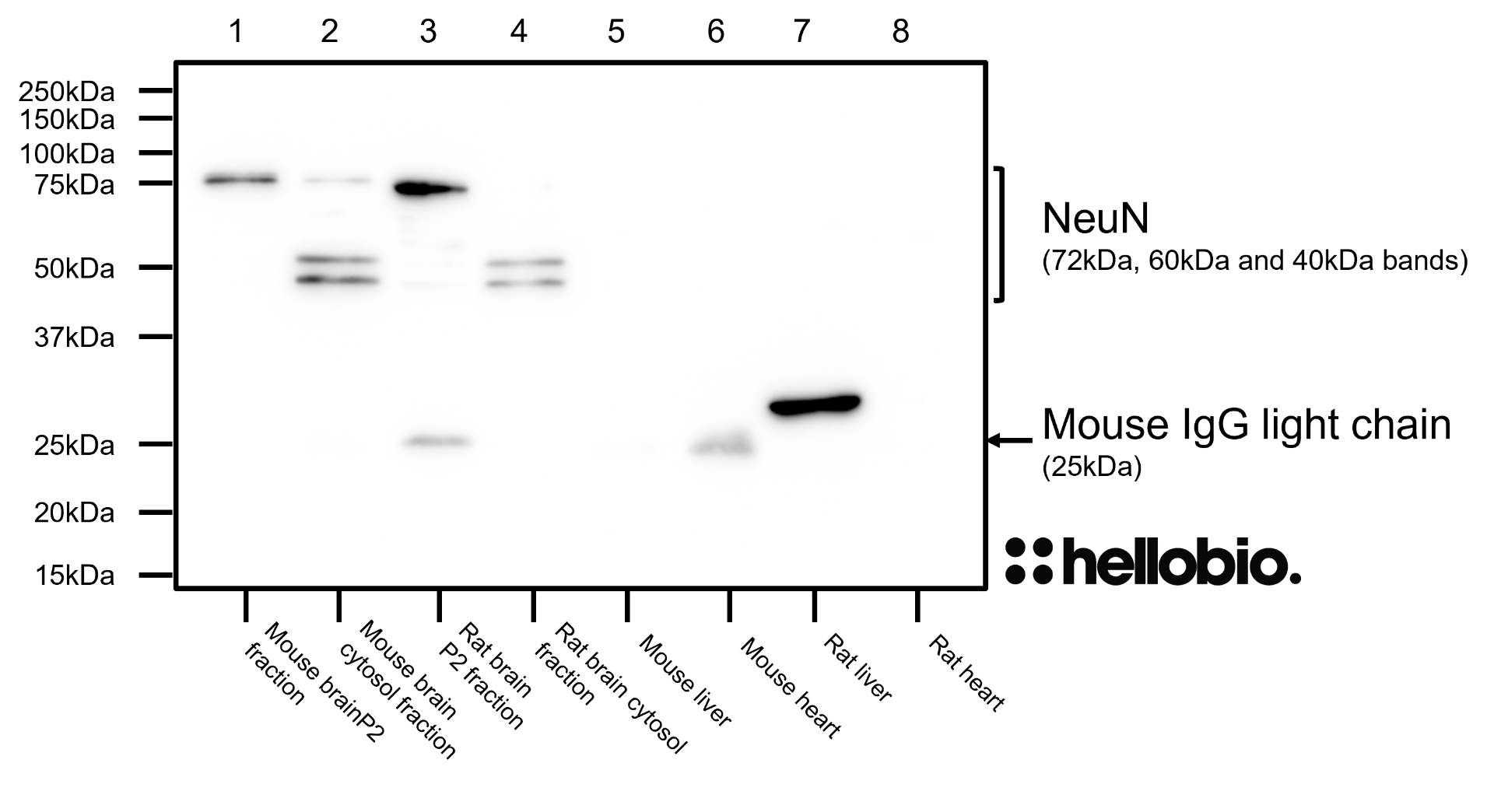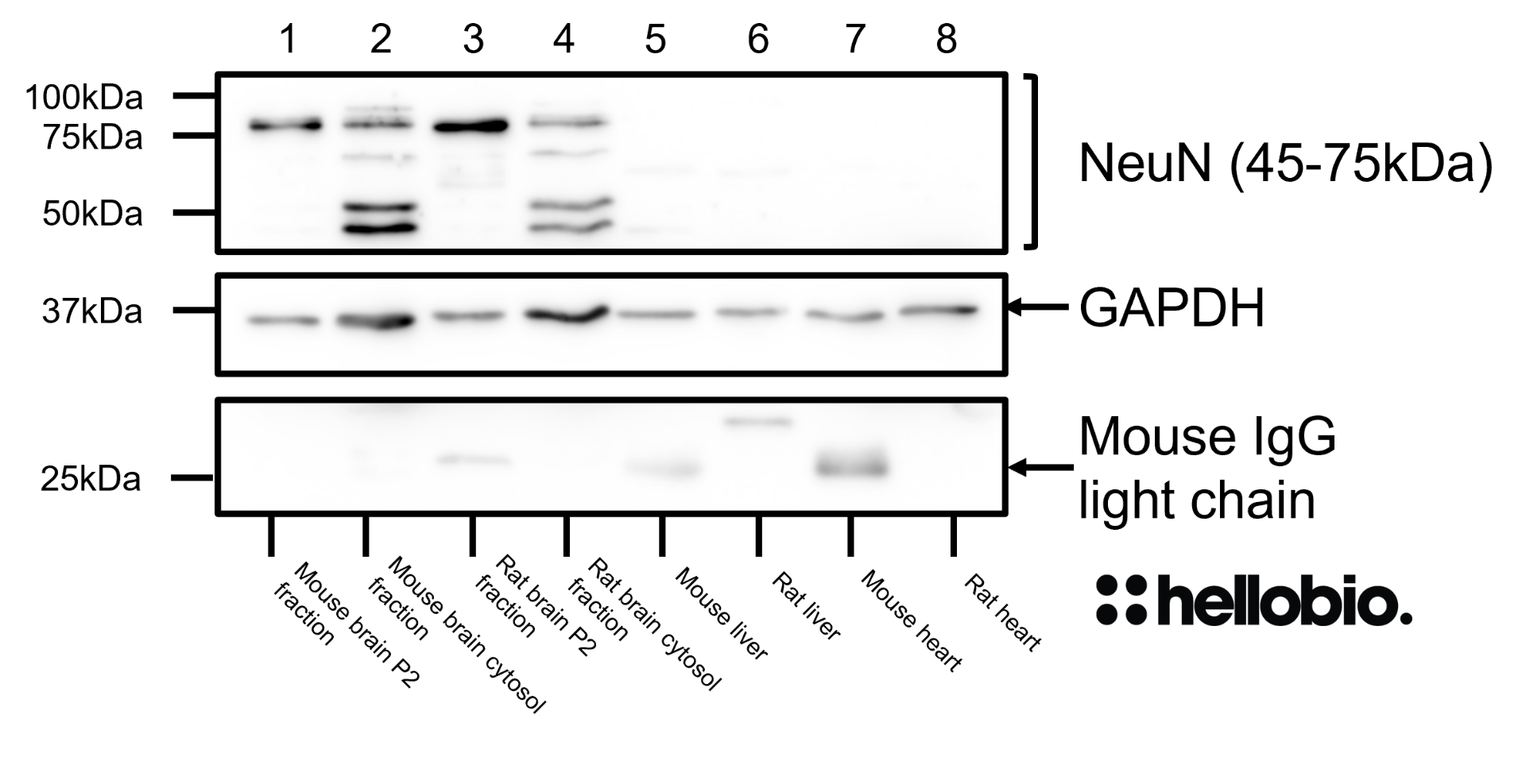![]()
|
Figure 7. NeuN expression in the granule cell layer of the rat dentate gyrus visualised using HB6429. HB6429 successfully stains the dense layer of neurones present in the rat dentate gyrus in PFA fixed sections. Method: hippocampi were dissected from rat brains and fixed overnight in 4% PFA before then being incubated in 30% sucrose (in PBS) for another 24hrs. A freezing microtome was used to cut 40µm transverse slices before sections were incubated in 0.05M glycine for 30 minutes. Sections were blocked in 1% BSA, 22.52mg/ml glycine before incubation overnight in HB6429 (1:1,000 dilution, 1µg/ml). This was followed by a two hour incubation with secondary antibody (Polyclonal goat anti-mouse DyLight 488 conjugated, Thermofisher 35503, 1:300 dilution). DAPI (HB0747) was used at 1µg/ml to visualise cell nuclei. For more detail please see our IHC(IF) protocol. The image was captured using a Leica SPE confocal laser scanning microscope coupled to a Leica DMi8 inverted epifluorescence microscope. The image was captured using a 40x objective (5.5x zoom) in a z-stack (168nm spacing) and 405 (20.0% power, gain: 494) / 488 (27.0% power, gain: 619) laser lines. The image was processed in ImageJ (Schindelin et al., 2012. Nat Methods, 9(7), 676–682). |
![]()
|
Figure 2. NeuN expression in the granule cell layer of the rat dentate gyrus visualised using HB6429. HB6429 successfully stains the dense layer of neurones present in the rat dentate gyrus in PFA fixed sections. Method: hippocampi were dissected from rat brains and fixed overnight in 4% PFA before then being incubated in 30% sucrose (in PBS) for another 24hrs. A freezing microtome was used to cut 40µm transverse slices before sections were incubated in 0.05M glycine for 30 minutes. Sections were blocked in 1% BSA, 22.52mg/ml glycine before incubation overnight in HB6429 (1:1,000 dilution, 1µg/ml). This was followed by a two hour incubation with secondary antibody (Polyclonal goat anti-mouse DyLight 488 conjugated, Thermofisher 35503, 1:300 dilution). DAPI (HB0747) was used at 1µg/ml to visualise cell nuclei. For more detail please see our IHC(IF) protocol. The image was captured using a Leica SPE confocal laser scanning microscope coupled to a Leica DMi8 inverted epifluorescence microscope. The image was captured using a 40x objective (1x zoom) and 405 (20.0% power, gain: 542) / 488 (27.0% power, gain: 542) laser lines. The image was processed in ImageJ (Schindelin et al., 2012. Nat Methods, 9(7), 676–682). |
![]()
|
Figure 3. The effect of varying HB6429 concentration upon staining in rat dentate gyrus. HB6429 successfully labelled the dense layer of neurones present in the granule cell layer of the dentate gyrus in 40µm rat hippocampal sections at a range of dilutions. Method: hippocampi were dissected from rat brains and fixed overnight in 4% PFA before then being incubated in 30% sucrose (in PBS) for another 24hrs. A freezing microtome was used to cut 40µm transverse slices before sections were incubated in 0.05M glycine for 30 minutes. Sections were blocked in 1% BSA, 22.52mg/ml glycine before incubation overnight in varying concentrations of HB6429 (1:500 to 1:4,000 dilutions, 0.25-2µg/ml). This was followed by a two hour incubation with secondary antibody (Polyclonal goat anti-mouse DyLight 488 conjugated, Thermofisher 35503, 1:300 dilution). DAPI (HB0747) was used at 1µg/ml to visualise cell nuclei (not shown due to obscuring NeuN signal in the dense cell layer). For more detail please see our IHC(IF) protocol. Images were captured using a Leica DM2500 epifluorescence microscope (20x objective) coupled to a Leica DFC7000T colour digital camera with DAPI and I3 filters. Exposure times were as follows:
1:500 - I3: 10x gain, 32.2ms exposure
1:1000 - I3: 10x gain, 10x gain, 22.3ms exposure
1:2000 – I3: 10x gain, 22.3ms exposure
1:4000 – I3: 10x gain, 17.9ms exposure
No primary - I3: 112.ms exposure (taken using different microscope: Leica DMI6000B with Photometric-Prime95B camera). |
![]()
|
Figure 4. NeuN expression in various tissue lysates and preparations. HB6429 revealed the double band of FOX-3 isoforms in the brain cytosol fractions and the single heavier band of Synapsin-1 present in P2 brain fractions. These bands are characteristic of antibodies raised against the NeuN antigen. Method: mouse brain and rat brain membrane (P2) and cytosol fractions were prepared following previous work (Molnar et al., 1993. Neuroscience 53:307-326) from freshly collected adult brains. Other tissue lysates were prepared following established protocols from freshly dissected tissue (see our guide on WB sample preparation). Samples were loaded (20µg / lane) onto a 12% acrylamide gel alongside a protein ladder (Thermofisher, 26616) before being run at 60V for 30 minutes followed by 120V for 100 minutes. Wet transfer to a PVDF membrane was completed in 100 minutes using 400mA. The membrane was blocked for 2hrs in 5% non-fat dry milk before being incubated overnight at 4°C in HB6429 at a 1:1,000 dilution (1µg/ml). Following washing, the membrane was incubated in secondary antibody (1:10,000 dilution, Polyclonal goat anti-mouse HRP conjugated, Sigma Aldrich A3682) for 2hrs. For more detail please see our Western blotting protocol. Detection was accomplished using Clarity Western ECL substrate (BioRad, 1705061) and a Licor Odyssey Fc imaging system (ECL channel: 10 min exposure, 700nm channel: 30 sec exposure). |
![]()
|
Figure 5. Concentration response of HB6429 staining in rat brain cytosol preparation. HB6429 shows consistent results with low background at dilutions as low as 1:16,000 (62.5 ng/ml). Method: Rat brain cytosol fractions were prepared following previous work (Molnar et al., 1993. Neuroscience 53:307-326) from freshly collected adult brains. Samples were loaded (20µg / lane) onto a 12% acrylamide gel alongside a protein ladder (Thermofisher, 26616) before being run at 60V for 30 minutes followed by 120V for 100 minutes. Wet transfer to a PVDF membrane was completed in 90 minutes using 400mA. Following transfer the membrane was cut into strips using Ponceau dye to visualise lanes. Strips were blocked for 2hrs in 5% non-fat dry milk before being incubated overnight at 4°C in HB6429. Each strip was incubated separately with a separate HB6429 concentration with this ranging from 2µg/ml (1:500 dilution) to 31.25ng/ml (1:32,000 dilution). Following washing, the membrane was incubated in secondary antibody (1:10,000 dilution, Polyclonal goat anti-mouse HRP conjugated, Sigma Aldrich A3682) for 2hrs. For more detail please see our Western blotting protocol. Detection was accomplished using Clarity Western ECL substrate (BioRad, 1705061) and a Licor Odyssey Fc imaging system (ECL channel: 10 min exposure, 700nm channel: 30 sec exposure). Band intensity was calculated using Image Studio version 5.2.5 (LiCor) and a graph was constructed in GraphPad Prism 9 using a 3-parameter Hill equation curve fit. |
![]()
|
Figure 6. NeuN expression in various tissue lysates and preparations including GAPDH (HB9177) loading control. HB6429 revealed the complex staining pattern resulting from antibodies raised against the NeuN antigen. Method: mouse brain and rat brain membrane (P2) and cytosol fractions were prepared following previous work (Molnar et al., 1993. Neuroscience 53:307-326) from freshly collected adult brains. Other tissue lysates were prepared following established protocols from freshly dissected tissue (see our guide on WB sample preparation). Samples were loaded (20µg / lane) onto a 12% acrylamide gel alongside a protein ladder (Thermofisher, 26616) before being run at 60V for 35 minutes followed by 120V for 100 minutes. Wet transfer to a PVDF membrane was completed in 90 minutes using 400mA. The membrane was blocked for 2hrs in 5% non-fat dry milk before being incubated overnight at 4°C in HB6429 at a 1:1,000 dilution (1µg/ml) and HB9177 (1:2,000 dilution, 0.5µg/ml). Following washing, the membrane was incubated in secondary antibody (1:10,000 dilution, Polyclonal goat anti-mouse HRP conjugated, Sigma Aldrich A3682) for 2hrs. For more detail please see our Western blotting protocol. Detection was accomplished using Clarity Western ECL substrate (BioRad, 1705061) and a Licor Odyssey Fc imaging system (ECL channel: 10 min exposure, 700nm channel: 30 sec exposure). |
![]()
|
Figure 1. NeuN expression in the rat dentate gyrus visualised using HB6429. HB6429 successfully stains the dense layer of neurones present in the rat dentate gyrus in PFA fixed sections. Method: hippocampi were dissected from rat brains and fixed overnight in 4% PFA before then being incubated in 30% sucrose (in PBS) for another 24hrs. A freezing microtome was used to cut 40µm transverse slices before sections were incubated in 0.05M glycine for 30 minutes. Sections were blocked in 1% BSA, 22.52mg/ml glycine before incubation overnight in HB6429 (1:500 dilution, 2µg/ml). This was followed by a two hour incubation with secondary antibody (Polyclonal goat anti-mouse DyLight 488 conjugated, Thermofisher 35503, 1:300 dilution). DAPI (HB0747) was used at 1µg/ml to visualise cell nuclei. For more detail please see our IHC(IF) protocol. The image was captured using a Leica DM2500 epifluorescence microscope (10x objective) coupled to a Leica DFC7000T colour digital camera with DAPI (10x gain, 14.4ms exposure) and I3 filters (10x gain, 73.0ms exposure). |









